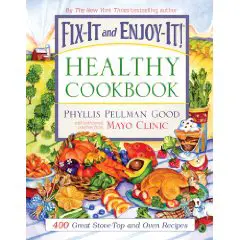To make health and nutrition simpler for families, New York Times bestselling cookbook author Phyllis Pellman Good collaborated with the Mayo Clinic on the book Fix-It and Enjoy-It!® Healthy Cookbook.

Below, you’ll find 12 “Tips for Helping Children Eat Healthy” from the Fix-It and Enjoy-It!® Healthy Cookbook:
1. Make it fun. Serve broccoli and other veggies with a favorite fat-free dip or sauce. Cut foods into various shapes with cookie cutters.
2. Recruit your child’s help. At the grocery store, ask your children to help you select fruits, vegetables, and other healthy foods. Don’t buy anything that you don’t want your child to eat. At home, let your child help choose what to eat, and also help you rinse veggies, stir batter, or set the table.
3. Be cunning. Add chopped broccoli or green peppers to spaghetti sauce, top cereal with fruit slices, and mix grated zucchini and carrots into casseroles and soups. Serve veggies first at mealtime, when children are hungriest.
4. Don’t offer dessert as reward. Withholding dessert sends the message that dessert is the best food, which may only increase your child’ desire for sweets. You might select one or two nights a week as dessert nights, and skip dessert the rest of the week. Or redefine dessert as fruit, yogurt, or other healthy choices.
5. Designate a snacking zone. Restrict snacking to the kitchen. You’ll save your children from mindless munching in front of the TV.
6. Make it quick. If your children need to snack on the go, think beyond a bag of potato chips. Offer string cheese, fresh fruit, cereal bars, or other drip-free items.
7. Go for the grain. Whole-grain snacks – such as a whole-grain pretzels or tortillas and low-sugar, whole-grain cereals – can give your children energy with some staying power.
8. Pull out the blender. Use skim milk, fat-free yoghurt, and fresh fruit to make your own smoothies.
9. Promote independence. Make it easy for older children to help themselves. Keep a selection of ready-to-eat veggie in the refrigerator. Leave fresh fruit in a bowl in the counter. Store low-sugar, whole-grain cereal in an easily accessible cabinet. Stock fruit, either canned or packaged in its own juice, in your pantry.
10. Use some imagination. Offer something new, such as fresh pineapple, cranberries, or roasted soy nuts. Slice a whole-wheat pita and serve with hummus.
11. Mix and match. Serve baby carrots or other raw veggies with fat-free ranch dressing. Dip graham crackers or fresh fruit in a fat-free yogurt. Top celery, apples, or bananas with peanut butter.
12. Set a good example. Let your children catch you munching raw vegetables or snacking on a bowl of grapes. If you eat a variety of healthy foods, your child is more likely to follow suit.
To win a copy of the Fix-It and Enjoy-It!® Healthy Cookbook, leave a comment below by February 28th sharing how you try to help your kids eat a healthy diet.